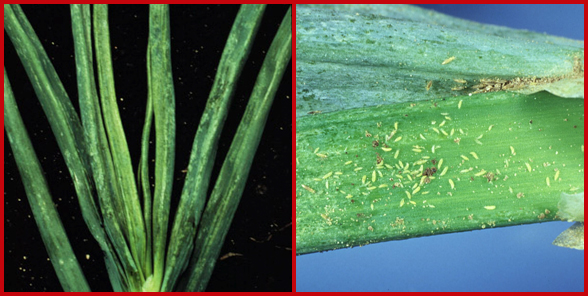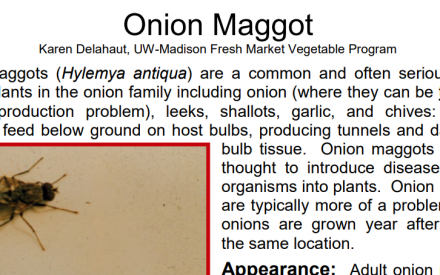Authors: David Lowenstein and Russell Groves, UW-Madison Entomology
Last Revised: 05/20/2020
X-number: XHT1134
Onion thrips (Thrips tabaci) are an important annual pest of onion. They can attack many garden crops, but most commonly cause serious damage to onions, leeks and garlic.
Appearance: Adult onion thrips are about 1/12 inch long, thin and pale yellow to brown in color. Their wings have only a single, central vein and are fringed with long hairs. Nymphs (immature thrips) resemble adults, but they are smaller and lack wings.

Symptoms and Effects: In general, onion thrips prefer tight spaces and cause severe damage on plants that produce tightly packed leaves. Feeding causes whitish blotches that may appear as silvery streaking on leaves. As feeding continues, affected tissue may turn dry and yellow, and may eventually brown and die. On flowering plants, thrips feeding can cause decreased pollen production. Onion thrips can also carry and inoculate plants with viruses such as Iris yellow spot virus (IYSV), Tomato spotted wilt virus (TSWV) and Impatiens necrotic spot virus (INSV). See University of Wisconsin Garden Facts HXT1139, Impatiens Necrotic Spot, for details on this latter virus.
On onions, thrips prefer to feed on the youngest leaves, and the tips of these leaves often brown and die. Thrips feeding can also lead to distorted and undersized bulbs. Cultivars that produce leaves close to the stems are more susceptible to thrips damage than cultivars with more open growth. Onions that have a more circular leaf structure and that have glossier foliage tend to be less prone to damage. Red onions are particularly susceptible to thrips damage, while Spanish onions tend to be somewhat more tolerant.
On cabbage, varieties with dense heads are most susceptible to damage. Heavy thrips feeding can cause cabbage heads to become distorted and leaves to have darkened blisters where feeling has occurred. On cauliflower, thrips damage causes tan or brown streaks on the curds. This damage can provide entry points for bacteria that cause bacterial soft rot (see University of Wisconsin Garden Facts HXT1224, Bacterial Soft Rot, for details).
Life Cycle: Onion thrips overwinter in legume (e.g., alfalfa) and grain (e.g., wheat) fields, in weedy areas, and in onion bulbs not removed from onion fields. Females can reproduce without mating and lay eggs on the undersides of leaves. Eggs hatch after five to 10 days. The first two thrips nymphal stages feed on plants. Two additional non-feeding nymph stages live in the soil or on the soil surface. Nymphs mature into adults after 15 to 30 days, and adults return to plants to feed. Thrips can produce five to eight generations per year, and outbreaks are most likely to occur in the summer during hot, dry periods.
Scouting: Thrips populations can develop very rapidly. Be sure to routinely and carefully monitor crops for thrips during the periods indicated in the table below. Use yellow or white sticky traps and carefully examine plants at the edge of home gardens (or commercial fields) to monitor for the initial movement of thrips early in the growing season. If you find three thrips per onion leaf, consider chemical treatments. However, some onion varieties (e.g., ‘Snow White’, ‘Vega’) are highly tolerant of thrips feeding even with up to 45 thrips per plant.
When to Scout for Squash Bugs
Scouting for Onion Thrips should be done in July, August, and early September.
Control:
Cultural: Remove plant debris from gardens (and commercial fields) as well as any areas surrounding a location where you will be growing onions or other susceptible vegetables.
Chemical: Apply insecticides each year as soon as thresholds (see above) have been exceeded to target the insects before they can reach protected areas (e.g., the insides cabbage heads and onion necks) where insecticides cannot easily penetrate. When using foliar sprays, direct the sprays down into the center of the plants to maximize penetration into protected areas. Also, use sufficient water, as well as a spray additive, to help the insecticide penetrate. Alternate use of at least two insecticide active ingredients to minimize development of insecticide-resistant thrips. See UW-Extension Publication A3422, Commercial Vegetable Production in Wisconsin, for a list of registered insecticides.
For more information on onion thrips: See UW-Extension Bulletin A3422, or contact your county Extension agent.
Download Article





 Onion Maggot
Onion Maggot Managing Thrips in Greenhouses
Managing Thrips in Greenhouses Tomato Spotted Wilt of Potato
Tomato Spotted Wilt of Potato Home Vegetable Insecticides
Home Vegetable Insecticides


